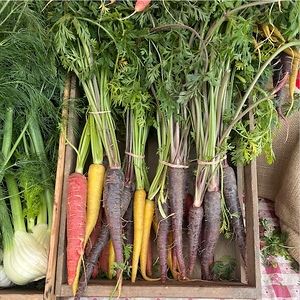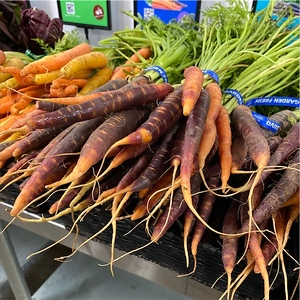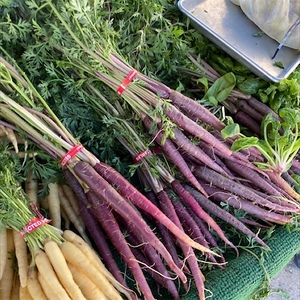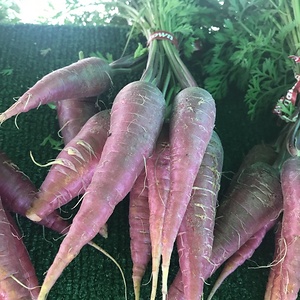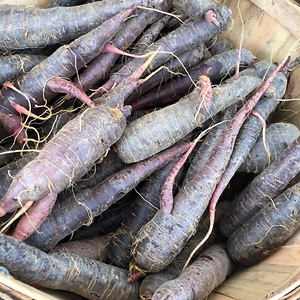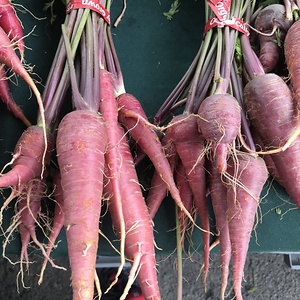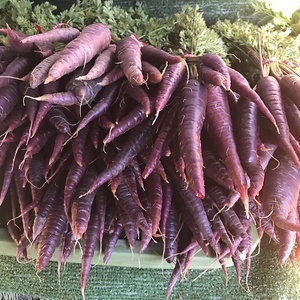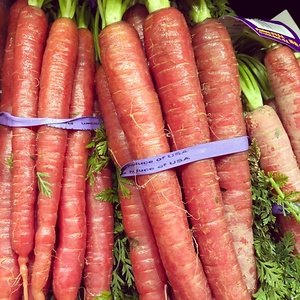


Red Bunched Carrots (Maroon)
Estimated Inventory, 24 ct : 1.99
This item was last sold on : 04/19/25
Description/Taste
Red carrots widely vary in size and are narrow to conical in shape, tapering to a point on the non-stem end. The skin is smooth, firm, and ranges in color from red, maroon, to red-purple. Underneath the surface, the flesh is crisp, orange to pale yellow, and dense with a higher water content than orange carrot varieties. Red carrots are crunchy with a snap-like quality and have an earthy, very sweet flavor. In addition to the roots, the leafy tops are also edible and have a fresh, slightly bitter, vegetal flavor.
Seasons/Availability
Red carrots are available year-round, with a peak season in the fall and winter.
Current Facts
Red carrots, botanically classified as Daucus carota subs. Sativus, are edible, underground roots that belong to the Apiaceae family along with parsnips, celery, and parsley. Considered to be one of the rarer carrot colors, Red carrots have been present since the beginning of carrot cultivation but are often overshadowed by orange varieties. There are many different varieties of Red carrots including Atomic Red, Red Samurai, Beta-Sweet, Kyoto Red, and Nutri Red, and the roots can also be sometimes found labeled as Pakistani carrots. Red carrots are mainly utilized in Asia and are favored in cooked applications over fresh eating.
Nutritional Value
Red carrots are a good source of fiber and beta-carotene and contain vitamin C, vitamin E, and calcium. They also contain lycopene, a naturally occurring pigment that doubles as an antioxidant. Lycopene is known for preventing, fighting, and repairing cell damage within the human body and is known to help improve skin.
Applications
Red carrots are best suited for cooked applications such as roasting, grilling, boiling, and steaming. The best preparation for the roots to not lose their color and nutritional properties is grilling. Red carrots can also be pickled for extended use, deep-fried, or cooked and served with meat and other root vegetables. In the Middle East, Red carrots are popularly made into a jam and is spread on waffles, toast, and pancakes or is mixed into baked goods, cereal, and yogurt. Red carrots pair well with almonds, bacon, butter, celery, cheeses such as cheddar, parmesan, and pecorino, cinnamon, ginger, parsley, potatoes, mushrooms, shallots, tomatoes, and vinegar. The roots will keep up to one month when stored loosely placed in a plastic bag with good air circulation in the crisper drawer of the refrigerator. Never store fruit along with carrots, as fruits expel ethylene gas that is readily absorbed by carrots. The carrots exposed to the ethylene gas will turn very bitter, making them not suitable for eating.
Ethnic/Cultural Info
In Texas, a Red carrot variety known as the Beta-Sweet was created from a passion project of Dr. Leonard Pike, a former professor at Texas A&M’s College of Agriculture and Life Sciences. It took over twelve years for the variety to be created from natural cross-breeding techniques, and the Beta-Sweet is known today for its very sweet flavor and for containing almost forty percent more beta-carotene than common red varieties. The Beta-sweet carrot was also intentionally bred a specific shade of maroon as an homage to one of the school colors of Texas A&M.
Geography/History
Red carrots originated over five thousand years ago in present-day Afghanistan in Central Asia. The roots were then spread to Eastern Asia and were highly cultivated there, developing natural hybrids and new cultivars varying in core color, size, and flavor. Through trade and expeditions, Red carrots were slowly introduced to the rest of the world, but orange carrot varieties have largely overshadowed their popularity. Today Red carrots are found at local farmers markets, specialty grocers, and in home gardens in Asia, especially in Japan, India, and Russia, and are also found in North America, Africa, Europe, and Australia.
Featured Restaurants
Restaurants currently purchasing this product as an ingredient for their menu.
| Black Raill Kitchen + Bar | Carlsbad CA | 619-454-9182 |
| Secret Sister | San Diego CA | 619-281-0718 |
| Aztec Shop Catering | San Diego CA | 619 594-3576 |
| Pamplemousse Grill | Solana Beach CA | 858-792-9090 |
| Sandpiper Wood Fired Grill & Oysters | La Jolla CA | 858-228-5655 |
| Harvest Kitchen | Vista CA | 619-709-0938 |
| Belmont Park Entertainment | San Diego CA | 858-228-9283 |
| Georges at the Cove | San Diego CA | 858-454-4244 |
| Huntress | San Diego CA | 619-955-5750 |
| Slowly | San Diego CA | 858-352-6080 |
| Jeune Et Jolie | Carlsbad CA | 858-231-0862 |
| Eddie V's La Jolla - EV# 8511 | La Jolla CA | 858-459-5500 |
| Farmer and The Seahorse | San Diego CA | 619-302-3682 |
| Two Ducks (Deliver Lion Share) | San Diego CA | 619-564-6924 |
| Hilton Garden Inn | San Diego CA | 858-720-9500 |
| Cove House | La Jolla CA | 858-999-0034 |
| Carte Hotel | San Diego CA | 619-365-1858 |
| The Lion Share | San Diego CA | 619-564-6924 |
| Harmony Cuisine 2B1 | San Diego CA | 858-737-4777 |
| Black Radish | San Diego CA | 619-775-7412 |
| US Grant Hotel Grill | San Diego CA | 619-232-3121 |
| Vulture / Dreamboat | San Diego CA | 858-342-3609 |
| The Plot | Oceanside CA | 422-266-8200 |
| 31ThirtyOne by Deckman | San Diego CA | 619-495-9814 |
| Mission Bay Beach Club | San Diego CA | 858-201-7551 |
| Camino Riviera | San Diego CA | 619-685-3881 |
| Tahona (Kitchen) | San Diego CA | 619-573-0289 |
| Sycuan Casino | El Cajon CA | 619-445-6002 |
| WaterBar | San Diego CA | 619-308-6500 |
| InterContinental Vistal Kitchen | San Diego CA | 619-501-9400 |
| Toast Catering | San Diego CA | 619-795-9135 |
| Hotel La Jolla - Sea & Sky | La Jolla CA | 858-459-0261 |
| Inn at Rancho Santa Fe | Rancho Santa Fe CA | 858-381-8289 |
| Mission Pacific | Oceanside CA | 760-450-7864 |
| Hilton Mission Valley | San Diego CA | 619-543-9000 |
| Patisserie Melanie | San Diego CA | 619-677-2132 |
| Mille Fleurs | Rancho Santa Fe CA | 858-756-3085 |
| Little Frenchie | Coronado CA | 619-522-6890 |
| Javier Plascencia (Animalon) | Bonita CA | 619-295-3172 |
Recipe Ideas
Recipes that include Red Bunched Carrots (Maroon). One
| The Hungry Bunnie |
|
Round Roast with Purple Maroon Carrots |
| Healthfully Ever After |
|
Maroon Sage Carrots |



